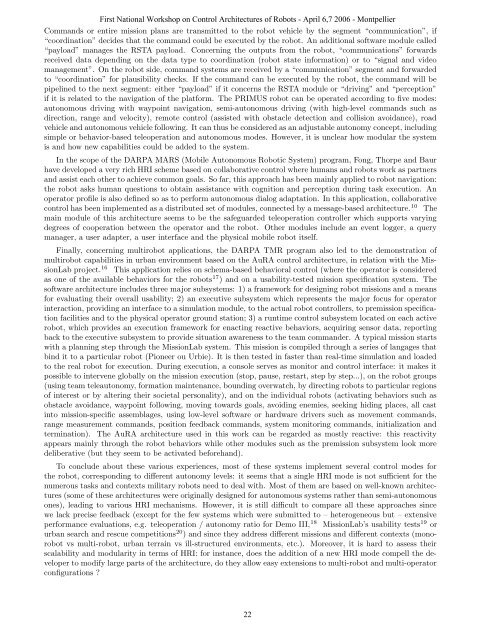Pleading for open modular architectures - Lirmm
Pleading for open modular architectures - Lirmm
Pleading for open modular architectures - Lirmm
You also want an ePaper? Increase the reach of your titles
YUMPU automatically turns print PDFs into web optimized ePapers that Google loves.
First National Workshop on Control Architectures of Robots - April 6,7 2006 - Montpellier<br />
Commands or entire mission plans are transmitted to the robot vehicle by the segment “communication”, if<br />
“coordination” decides that the command could be executed by the robot. An additional software module called<br />
“payload” manages the RSTA payload. Concerning the outputs from the robot, “communications” <strong>for</strong>wards<br />
received data depending on the data type to coordination (robot state in<strong>for</strong>mation) or to “signal and video<br />
management”. On the robot side, command systems are received by a “communication” segment and <strong>for</strong>warded<br />
to “coordination” <strong>for</strong> plausibility checks. If the command can be executed by the robot, the command will be<br />
pipelined to the next segment: either “payload” if it concerns the RSTA module or “driving” and “perception”<br />
if it is related to the navigation of the plat<strong>for</strong>m. The PRIMUS robot can be operated according to five modes:<br />
autonomous driving with waypoint navigation, semi-autonomous driving (with high-level commands such as<br />
direction, range and velocity), remote control (assisted with obstacle detection and collision avoidance), road<br />
vehicle and autonomous vehicle following. It can thus be considered as an adjustable autonomy concept, including<br />
simple or behavior-based teleoperation and autonomous modes. However, it is unclear how <strong>modular</strong> the system<br />
is and how new capabilities could be added to the system.<br />
In the scope of the DARPA MARS (Mobile Autonomous Robotic System) program, Fong, Thorpe and Baur<br />
have developed a very rich HRI scheme based on collaborative control where humans and robots work as partners<br />
and assist each other to achieve common goals. So far, this approach has been mainly applied to robot navigation:<br />
the robot asks human questions to obtain assistance with cognition and perception during task execution. An<br />
operator profile is also defined so as to per<strong>for</strong>m autonomous dialog adaptation. In this application, collaborative<br />
control has been implemented as a distributed set of modules, connected by a message-based architecture. 10 The<br />
main module of this architecture seems to be the safeguarded teleoperation controller which supports varying<br />
degrees of cooperation between the operator and the robot. Other modules include an event logger, a query<br />
manager, a user adapter, a user interface and the physical mobile robot itself.<br />
Finally, concerning multirobot applications, the DARPA TMR program also led to the demonstration of<br />
multirobot capabilities in urban environment based on the AuRA control architecture, in relation with the MissionLab<br />
project. 16 This application relies on schema-based behavioral control (where the operator is considered<br />
as one of the available behaviors <strong>for</strong> the robots 17 ) and on a usability-tested mission specification system. The<br />
software architecture includes three major subsystems: 1) a framework <strong>for</strong> designing robot missions and a means<br />
<strong>for</strong> evaluating their overall usability; 2) an executive subsystem which represents the major focus <strong>for</strong> operator<br />
interaction, providing an interface to a simulation module, to the actual robot controllers, to premission specification<br />
facilities and to the physical operator ground station; 3) a runtime control subsystem located on each active<br />
robot, which provides an execution framework <strong>for</strong> enacting reactive behaviors, acquiring sensor data, reporting<br />
back to the executive subsystem to provide situation awareness to the team commander. A typical mission starts<br />
with a planning step through the MissionLab system. This mission is compiled through a series of langages that<br />
bind it to a particular robot (Pioneer ou Urbie). It is then tested in faster than real-time simulation and loaded<br />
to the real robot <strong>for</strong> execution. During execution, a console serves as monitor and control interface: it makes it<br />
possible to intervene globally on the mission execution (stop, pause, restart, step by step...), on the robot groups<br />
(using team teleautonomy, <strong>for</strong>mation maintenance, bounding overwatch, by directing robots to particular regions<br />
of interest or by altering their societal personality), and on the individual robots (activating behaviors such as<br />
obstacle avoidance, waypoint following, moving towards goals, avoiding enemies, seeking hiding places, all cast<br />
into mission-specific assemblages, using low-level software or hardware drivers such as movement commands,<br />
range measurement commands, position feedback commands, system monitoring commands, initialization and<br />
termination). The AuRA architecture used in this work can be regarded as mostly reactive: this reactivity<br />
appears mainly through the robot behaviors while other modules such as the premission subsystem look more<br />
deliberative (but they seem to be activated be<strong>for</strong>ehand).<br />
To conclude about these various experiences, most of these systems implement several control modes <strong>for</strong><br />
the robot, corresponding to different autonomy levels: it seems that a single HRI mode is not sufficient <strong>for</strong> the<br />
numerous tasks and contexts military robots need to deal with. Most of them are based on well-known <strong>architectures</strong><br />
(some of these <strong>architectures</strong> were originally designed <strong>for</strong> autonomous systems rather than semi-autonomous<br />
ones), leading to various HRI mechanisms. However, it is still difficult to compare all these approaches since<br />
we lack precise feedback (except <strong>for</strong> the few systems which were submitted to – heterogeneous but – extensive<br />
per<strong>for</strong>mance evaluations, e.g. teleoperation / autonomy ratio <strong>for</strong> Demo III, 18 MissionLab’s usability tests 19 or<br />
urban search and rescue competitions 20 ) and since they address different missions and different contexts (monorobot<br />
vs multi-robot, urban terrain vs ill-structured environments, etc.). Moreover, it is hard to assess their<br />
scalability and <strong>modular</strong>ity in terms of HRI: <strong>for</strong> instance, does the addition of a new HRI mode compell the developer<br />
to modify large parts of the architecture, do they allow easy extensions to multi-robot and multi-operator<br />
configurations ?<br />
22

















